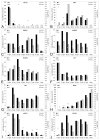Identification of genes differentially expressed during prenatal development of skeletal muscle in two pig breeds differing in muscularity
- PMID: 17908293
- PMCID: PMC2147030
- DOI: 10.1186/1471-213X-7-109
Identification of genes differentially expressed during prenatal development of skeletal muscle in two pig breeds differing in muscularity
Abstract
Background: Postnatal muscle growth is largely depending on the number and size of muscle fibers. The number of myofibers and to a large extent their metabolic and contractile properties, which also influence their size, are determined prenatally during the process of myogenesis. Hence identification of genes and their networks governing prenatal development of skeletal muscles will provide insight into the control of muscle growth and facilitate finding the source of its variation. So far most of the genes involved in myogenesis were identified by in vitro studies using gene targeting and transgenesis. Profiling of transcriptome changes during the myogenesis in vivo promises to obtain a more complete picture. In order to address this, we performed transcriptome profiling of prenatal skeletal muscle using differential display RT-PCR as on open system with the potential to detect novel transcripts. Seven key stages of myogenesis (days 14, 21, 35, 49, 63, 77 and 91 post conception) were studied in two breeds, Pietrain and Duroc, differing markedly in muscularity and muscle structure.
Results: Eighty prominent cDNA fragments were sequenced, 43 showing stage-associated and 37 showing breed-associated differences in the expression, respectively. Out of the resulting 85 unique expressed sequence tags, EST, 52 could be assigned to known genes. The most frequent functional categories represented genes encoding myofibrillar proteins (8), genes involved in cell adhesion, cell-cell signaling and extracellular matrix synthesis/remodeling (8), genes regulating gene expression (8), and metabolism genes (8). Some of the EST that showed no identity to any known transcripts in the databases are located in introns of known genes and most likely represent novel exons (e.g. HMGA2). Expression of thirteen transcripts along with five reference genes was further analyzed by means of real-time quantitative PCR. Nine of the target transcripts showed higher than twofold differences in the expression between the two breeds (GATA3, HMGA2, NRAP, SMC6L1, SPP1, RAB6IP2, TJP1 and two EST).
Conclusion: The present study revealed several genes and novel transcripts not previously associated with myogenesis and expands our knowledge of genetic factors operating during myogenesis. Genes that exhibited differences between the divergent breeds represent candidate genes for muscle growth and structure.
Figures


Similar articles
-
Comparative analyses by sequencing of transcriptomes during skeletal muscle development between pig breeds differing in muscle growth rate and fatness.PLoS One. 2011;6(5):e19774. doi: 10.1371/journal.pone.0019774. Epub 2011 May 26. PLoS One. 2011. PMID: 21637832 Free PMC article.
-
LongSAGE analysis of skeletal muscle at three prenatal stages in Tongcheng and Landrace pigs.Genome Biol. 2007;8(6):R115. doi: 10.1186/gb-2007-8-6-r115. Genome Biol. 2007. PMID: 17573972 Free PMC article.
-
MicroRNA expression profiles differ between primary myofiber of lean and obese pig breeds.PLoS One. 2017 Jul 31;12(7):e0181897. doi: 10.1371/journal.pone.0181897. eCollection 2017. PLoS One. 2017. PMID: 28759650 Free PMC article.
-
Building muscle: molecular regulation of myogenesis.Cold Spring Harb Perspect Biol. 2012 Feb 1;4(2):a008342. doi: 10.1101/cshperspect.a008342. Cold Spring Harb Perspect Biol. 2012. PMID: 22300977 Free PMC article. Review.
-
Comparative myogenesis in teleosts and mammals.Cell Mol Life Sci. 2014 Aug;71(16):3081-99. doi: 10.1007/s00018-014-1604-5. Epub 2014 Mar 25. Cell Mol Life Sci. 2014. PMID: 24664432 Free PMC article. Review.
Cited by
-
Dual effect of a single nucleotide polymorphism in the first intron of the porcine secreted phosphoprotein 1 gene: allele-specific binding of C/EBP beta and activation of aberrant splicing.BMC Mol Biol. 2009 Oct 21;10:96. doi: 10.1186/1471-2199-10-96. BMC Mol Biol. 2009. PMID: 19845957 Free PMC article.
-
Genetic analysis of tongue size and taste papillae number and size in recombinant inbred strains of mice.Chem Senses. 2008 Oct;33(8):693-707. doi: 10.1093/chemse/bjn025. Epub 2008 Jul 24. Chem Senses. 2008. PMID: 18653645 Free PMC article.
-
Osteopontin, inflammation and myogenesis: influencing regeneration, fibrosis and size of skeletal muscle.J Cell Commun Signal. 2014 Jun;8(2):95-103. doi: 10.1007/s12079-013-0217-3. Epub 2013 Dec 8. J Cell Commun Signal. 2014. PMID: 24318932 Free PMC article.
-
Four loci differentially expressed in muscle tissue depending on water-holding capacity are associated with meat quality in commercial pig herds.Mol Biol Rep. 2010 Jan;37(1):595-601. doi: 10.1007/s11033-009-9856-0. Mol Biol Rep. 2010. PMID: 19823956
-
High mobility group A2 (HMGA2) deficiency in pigs leads to dwarfism, abnormal fetal resource allocation, and cryptorchidism.Proc Natl Acad Sci U S A. 2018 May 22;115(21):5420-5425. doi: 10.1073/pnas.1721630115. Epub 2018 May 7. Proc Natl Acad Sci U S A. 2018. PMID: 29735702 Free PMC article.
References
-
- Rehfeldt C, Fiedler I, Dietl G, Ender K. Myogenesis and postnatal skeletal muscle cell growth as influenced by selection. Livest Prod Sci. 2000;66:177–188. doi: 10.1016/S0301-6226(00)00225-6. - DOI
-
- Wimmers K, Ngu NT, Jennen DGJ, Tesfaye D, Murani E, Schellander K, Ponsuksili S. Muscle size-associated transcript abundance of myosin heavy chain isoforms in longissimus dorsi muscle in different pig breeds. J Anim Sci. 2007.
-
- Ashmore CR, Addis PB, Doerr L. Development of Muscle Fibers in Fetal Pig. J Anim Sci. 1973;36:1088–1093. - PubMed
Publication types
MeSH terms
Substances
LinkOut - more resources
Full Text Sources
Research Materials
Miscellaneous

